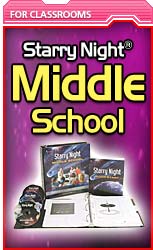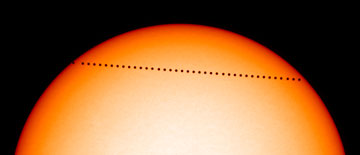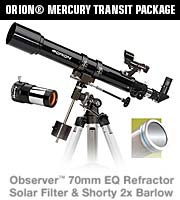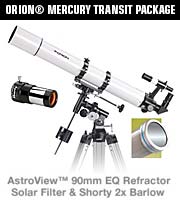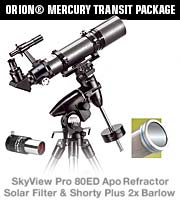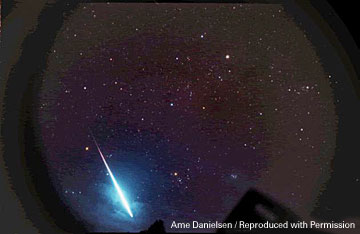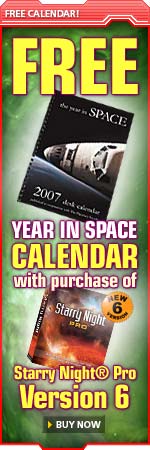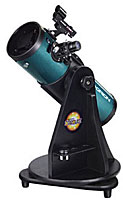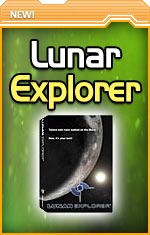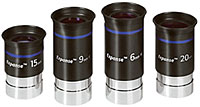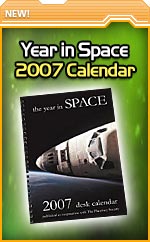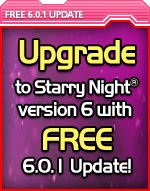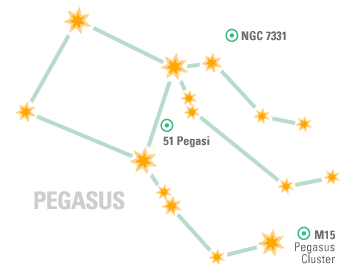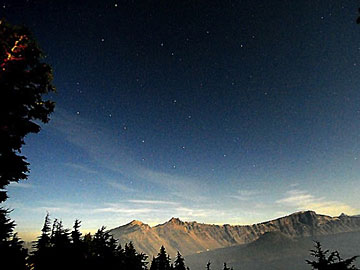 |
||||||||||||||||||||||||||||||||||||||||||||||||||||||||||||||||||||||||||||||||
|
If you have trouble viewing this newsletter, click here. Welcome again to our monthly newsletter with features on exciting celestial events, product reviews, tips & tricks, and a monthly sky calendar. This year, November furnishes amateur astronomers with two outstanding celestial events. On November 8, a rare Mercury transit puts a spot on the sun for several hours and, on the night of November 18, the Leonid Meteor Shower peaks, producing perhaps as many as 150 meteors per hour this year. Whether you own a telescope or not, we'll tell you where to look and what to expect.
Robbinsdale Area Schools District serves approximately 13,000 K-12 students and operates 11 elementary schools for students in grades K-5, three middle schools for grades 6-8, two high schools for 9-12 and one alternative high school. A customized teacher training has been scheduled for November 3. If you are interested in a Starry Night® Orientation or Teacher Training for your school or district, please contact Mike Goodman at mgoodman@imaginova.com or (952) 653-0493. In-person or webinar trainings available. Linda Fung
Become a Starry Night® Affiliate! If you publish a space or astronomy Web site or blog, earn extra cash by promoting Starry Night® on your Web site. We want sites that educate, entertain and share with others their passion for space and astronomy and will enthusiastically promote Starry Night® products. Join the Starry Night® affiliate program and earn referral commissions by sending customers to our site. When a visitor to your site clicks on the affiliate link to our site and completes a purchase, you get a 15% commission on every item they buy from the Starry Night® Store. It's easy to join and it's free! To be part of the Starry Night® affiliate program, you will need to sign up with our partner, Commission Junction. This application process will allow you to create a Commission Junction account and be an affiliate for Starry Night® as well as any of the merchants in the Commission Junction network. We have partnered with Commission Junction to provide our affiliates with tracking, reporting, prompt monthly payments, and the flexibility of being an affiliate for any of Commission Junction's other merchants. For more information or to sign up, please visit: Once approved, you'll receive a unique ID and specialized HTML links to track your traffic and revenue. Linda Fung
On November 8th 2006, amateur astronomers with small telescopes and solar filters will be able to observe Mercury's tiny silhouette moving slowly across the face of the Sun as it makes a rather feeble attempt to eclipse the Sun. Astronomers call this event a "transit".
Because Mercury orbits the Sun much more rapidly than Venus, it's in the right place for a transit far more often. Transits of Mercury occur 13 times a century or roughly once every 7.4 years, whereas transits of Venus occur less than twice a century, or roughly once every 62.5 years. In fact, transits of Venus usually occur in pairs 8 years apart, separated by a gap of 125 years. We're right in between a pair of Venus transits, one having occurred on June 08, 2004 and the next one on June 06, 2012.
This year's transit will be a late afternoon event for most of North and South America and a morning event for East Asia and Australia. The Mercury transit is not visible from Europe, Africa, and most of Asia. Choose an Observing Location In eastern North and South America the Sun will set before the transit is over, so it's important to observe from a site with a good western horizon. The one imponderable in observing a transit is of course the weather. Unlike a solar eclipse, where observers are restricted to a narrow band, transits are visible over a wide area. In case of inclement weather, you should be prepared to travel; the Clear Sky Clock will be a useful guide to where to go:
To read the rest of this article, please download our special six-page Mercury Transit PDF [468KB].
If you live in Western Europe or eastern North America, put a big circle on your calendar around Saturday, Nov. 18. If that night is clear, bundle up warmly and head outside because you may be able to catch a glimpse of an intense, albeit brief display of Leonid meteors.
Norwegian astrophotographer Arne Danielsen captured The Leonids are composed of the dusty debris that has been shed by the comet Temple-Tuttle, a small celestial body that orbits the Sun at 33-year intervals. In those years during and then for several years after the comet has swept through the inner solar system, it has had a propensity for producing spectacular meteor displays; meteors falling by the hundreds, if not thousands per hour. These "shooting stars" all apparently emanate from the constellation of Leo, the Lion. Hence the name "Leonids." The great years The comet last passed the Sun and Earth in 1998, and from that year through 2002, the Leonids produced showers in which meteors fell at rates of more than a thousand per hour—displays that astronomers call meteor storms. Since 2003, however, with Temple-Tuttle having receded back into the far reaches of the solar system, the Leonids have been disappointing, barely producing more than 10 meteors per hour. It appeared that the chances of any more spectacular Leonid displays were over for many years to come. But that might not be case, if the calculations of several reputable meteor scientists prove to be correct. Prediction for 2006 Apparently, a rather narrow but dense ribbon of dust was shed by comet Temple-Tuttle when it passed the Sun in 1932. When the Earth interacted with that dusty trail back in 1969, it produced a brief bevy of some 200 to 300 meteors in less than hour. In 2006, Earth will be nearly twice as far away from the comet as opposed to 1969, but expectations are that as many as 100 to 150 Leonids may streak across the sky in only an hour’s time as we interact with that decades-old ribbon of debris again. The expected time of peak activity is 11:45 p.m. EST on the night of Nov. 18. Where to watch For those living in eastern North America, the constellation of Leo will be rising in the eastern sky. Unfortunately, those living across the central and western parts of the United States and Canada will be out of luck, since Leo will not yet have risen and the expected peak of the display will be over when Leo finally comes above the horizon. Skywatchers in Western Europe will have ringside seats: The peak is due early on Sunday morning, Nov. 19 at 4:45 GMT. Leo will be high in the southeast sky, just before sunrise affording the very best Leonid views. Meteor watching is easy. Simply find the darkest location you can with a clear view of the eastern horizon. Then go out and look up. Binoculars and telescopes are of no use . See SPACE.com's meteor watching tips. SPACE.com will provide a detailed viewer's guide to the 2006 Leonid meteor shower on Nov. 17. Joe Rao |
Nov 2006
|
|||||||||||||||||||||||||||||||||||||||||||||||||||||||||||||||||||||||||||||||
|
The reviews of this little telescope were very positive. The telescope had been marketed as a kids’ telescope, but after the reviews came out, many adults bought these scopes because of their optical quality and portability. In fact, I was one of the early purchasers of the classic StarBlast™. I remember taking it to a public star party sponsored by my astronomy club, and ending up with a long line of viewers who were taken by the small size (and price) of this scope and by the fine image of Jupiter and its moons that it was delivering. The main drawback of this scope, shared by all so-called “table top” telescopes, is that it is hard to find a table top suitable for supporting it. Most tables have four legs, which makes them unstable on all but the most level surface, and few are solid enough to support a telescope magnifying a hundred times or more. Also, the table needs to be pretty small, so that you can approach the telescope from different directions, depending on where it is pointing in the sky. This problem was discussed by StarBlast™ owners on online forums, and various solutions proposed and tried out. The ideal support would probably be a three legged stool, but such things are hard to come by. Recently, the folks at Orion® came up with a different idea, what they call the “adult” version of the StarBlast™. This replaces the original Dobsonian style mount with their smallest equatorial mount (on a tripod), the EQ-1. This raises the scope to a suitable height for adult observers. Another change is replacing the 17mm and 6mm Explorer II eyepieces provided with the original with 15mm and 6mm Expanse™ eyepieces. These offer a wider field of view (66° vs. 50°) and longer eye relief, making them easier for eyeglass wearers to use (see below). I was recently loaned one of these scopes to review.
The optics on this equatorial version proved to be as good as in my “classic” version. A star test using Vega showed clean concentric diffraction patterns consistent with 1/4 wave correction with only a slight hint of surface roughness. The new Expanse™ eyepieces gave pleasing wide vistas. The tripod on the equatorial mount raises the telescope to a comfortable height for “sit-down” observing, though the controls are harder to operate in the dark than the original StarBlast™ mount. The EZ Finder II red dot finder made it easy to locate objects. I particularly enjoyed my views of large objects like the Pleiades (Messier 45) and the Andromeda Galaxy (Messier 31), along with its companion galaxies Messier 32 and Messier 110. The glittering jewels of the Double Cluster in Perseus were absolutely spectacular in this scope. The 2.2 degree field of view of the 15mm Expanse™ eyepiece gives wide vistas simply unobtainable on most other telescopes. It’s these wide-field low-power views offered by the StarBlast™ that have made it so popular with many experienced amateur astronomers. Unfortunately, neither the Moon nor any bright planets were available when I was testing, but I know from previous experience that these optics are capable of delivering pleasing views at 125 power or more on these objects. Though I think my first choice would still be the Dobsonian mounted version of this scope because of its simplicity of use, the EQ version is also an excellent choice either for a beginner or for an experienced amateur astronomer with a larger more powerful scope who wants a compact lightweight grab-and-go scope which will afford wide vistas of sky, yet is also capable of pleasing views of the Moon and planets. Geoff Gaherty |

Lunar Explorer is the world's most accurate and complete simulation of the old and familiar Moon. |
|||||||||||||||||||||||||||||||||||||||||||||||||||||||||||||||||||||||||||||||
|
Until recently, high power eyepieces usually meant cramming your eye against a tiny eye lens and viewing a dim narrow field. Then optical designers got the idea of combining eyepieces and Barlow lenses into a single package which gave high magnification, long eye relief, and bright, easy-to-see images. Such eyepieces have been quite expensive until Orion® recently announced their new Expanse™ series of eyepieces, available in four focal lengths: 20mm, 15mm, 9mm, and 6mm. The 20mm and 15mm are normal wide-field designs, while the 9mm and 6mm versions combine a fairly low power eyepiece with a built-in Barlow lens. That’s why, if you look at the picture above, the 9mm and 6mm versions are nearly twice as large as their low-power brethren, the opposite of what we see with most eyepieces. So, while the 20mm and 15mm are nice to have, the real interest is in the 9mm and 6mm versions, which offer a totally different viewing experience from typical short-focus Plössl eyepieces. I tested the 15mm and 6mm Expanse™ eyepieces which came with the StarBlast™ EQ as standard equipment. Both offer wide 66° fields of view, as compared with the 52° fields of most Plössls. This gives you a 61% increase in the area you can see at a given magnification, which in itself is impressive. Secondly the lens you put your eye to is much larger than we’re used to in eyepieces of this size. The eye lens on the 15mm measures 20mm in diameter, and that of the 6mm measures a whopping 22mm. The effect is like looking through a picture window rather than straining to peep through a tiny pinhole. This contributes to the large eye relief of these eyepieces, 13mm to 17mm, depending on the focal length. Eyeglass wearers will be able to see all or most of the field of view, and for non-eyeglass wearers, it will be just as comfortable to look through the 6mm as through the 20mm. These eyepieces come with all the deluxe features you expect from a high quality eyepiece:
In addition to testing these eyepieces in the StarBlast™ EQ, I also tried them in my Starmaster 11” f/4.3 Newtonian. As I always do with this telescope, I used a Tele Vue Paracorr to correct for the aberrations of its short focal ratio mirror; this results in an effective focal ratio of f/5, a pretty stringent test for any eyepiece. The Expanses delivered really sharp images almost to the very edge of their wide field, challenging eyepieces costing many times more. Once again, the Double Cluster in Perseus was my acid test, and both eyepieces delivered pleasingly sharp images all the way across their 66° field of view. With eyepieces like these Expanses available now at such a reasonable price, why even consider Plössls with their narrow fields of view and short eye relief? Geoff Gaherty |

The world's only desk calendar devoted to space exploration and astronomy. |
|||||||||||||||||||||||||||||||||||||||||||||||||||||||||||||||||||||||||||||||
|
If you are someone who waits for the .0.1 release of new software, then there's never been a better time to upgrade to Starry Night® new version 6 - now with free downloadable update to version 6.0.1! Only users of Starry Night® version 6.0 qualify for the free downloadable 6.0.1 update. If you already own version 6, below are instructions on how to download your 6.0.1 update. You must be connected to the Internet to receive the update. Windows users should click on Start>All Programs>Starry Night® (Enthusiast 6, Pro 6, Pro 6 AstroPhoto or Pro Plus 6) >Check for Starry Night® (Enthusiast 6, Pro 6, Pro 6 AstroPhoto or Pro Plus 6) Updates. Macintosh users should click on Macintosh HD>Applications>Starry Night® (Enthusiast 6, Pro 6, Pro 6 AstroPhoto or Pro Plus 6) >(Enthusiast 6, Pro 6, Pro 6 AstroPhoto or Pro Plus 6) Updater. You can also download the 6.0.1 update as a standalone updater file. This will allow you to save the update to a CD and then install it later. The updater will only update Starry Night® version 6.0.0 to 6.0.1. The size of the updates ranges from 13 to 38 MB. Please download and install only the update specified for your product. Installing the wrong update will corrupt your copy of Starry Night®. Click below for the standalone updaters: Please be patient as there may be a number of people downloading at the same time. Some highlights of the free 6.0.1 Update include: Significant improvements in Windows startup times.
Usability enhancements and fixes
Corrections to graphic anomalies
For Pro Plus users, you change the color of the nebula outlines, and they will draw as black in printouts. The AllSky image now correctly flips at small FOVs (hardware permitting). Click here to see a complete list of over 40 fixes: Upgrade to version 6 to receive the Free 6.0.1 update! Thank you for supporting Starry Night®. Linda Fung |

Based on the version of Starry Night® you have, you can upgrade to Enthusiast, Pro or Pro Plus version 6 or AstroPhoto Suite. For the first time, if you are using a planetarium or star charting program other than Starry Night®, you may qualify for special upgrade pricing to version 6. |
|||||||||||||||||||||||||||||||||||||||||||||||||||||||||||||||||||||||||||||||
|
Visit Starry Night® as we hit the road this fall and make stops at these conferences:
Linda Fung |
||||||||||||||||||||||||||||||||||||||||||||||||||||||||||||||||||||||||||||||||
|
M15 is one of the most densely packed globular clusters in our galaxy, with a high number of variable stars and pulsars. Viewable with the naked eye from dark sites, binoculars and small scopes will bring out some detail of the collapsed, superdense core. M15 is also one of only a handful of globular clusters known to contain a planetary nebula. NGC 7331, a Type 2 Seyfert galaxy about 43 million light-years away, shows a superb spiral structure. 51 Pegasi is an unexceptional 8th Mag star, but it's notable because it is orbited by the first true extrasolar planet to have been discovered. Sean O'Dwyer |
||||||||||||||||||||||||||||||||||||||||||||||||||||||||||||||||||||||||||||||||
|
The Big Dipper over Crater Lake, Oregon
Taken on September 8, 2006 with a Nikon D-200 and a Nikkor Wide Angle Lens (12-24mm). The ISO was 1600 and the exposure was 20 seconds. Michel Hersen, Portland, Oregon.
PRIZES AND RULES: We would like to invite all Starry Night® users to send their quality astronomy photographs to be considered for use in our monthly newsletter.
Please read the following guidelines and see the submission e-mail address below.
|
||||||||||||||||||||||||||||||||||||||||||||||||||||||||||||||||||||||||||||||||
 |
||||||||||||||||||||||||||||||||||||||||||||||||||||||||||||||||||||||||||||||||
|
Free Year in Space 2007 Calendar ($11.95 value) with purchase of Starry Night® Pro or Pro Plus version 6 only applies to the purchase of a new full box version of Starry Night® Pro or Pro Plus version 6. To receive the free Year in Space Calendar, this item must be selected and listed in your shopping cart before checkout. Limited to 1 Year in Space Calendar per purchase. Offer expires October 31, 2006 11:59 pm EST. Not valid on previous purchases. |
||||||||||||||||||||||||||||||||||||||||||||||||||||||||||||||||||||||||||||||||
You have received this e-mail as a trial user of Starry Night® Digital Download
or as a registrant at starrynight.com. To unsubscribe, click here.
